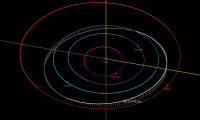Difference between revisions of "162173 Ryugu"
(Added 'In popular culture'.) |
(Fixed typo.) |
||
| Line 65: | Line 65: | ||
==In popular culture== | ==In popular culture== | ||
| − | Ryugu is the setting of the novel ''Delta-T'' by [w:Daniel Suarez|Daniel Suarez]] depicting miners who explore this body. | + | Ryugu is the setting of the novel ''Delta-T'' by [[w:Daniel Suarez|Daniel Suarez]] depicting miners who explore this body. |
Revision as of 04:16, 16 January 2025
|
Project home: Ryugu-00.zip |
162173 Ryugu or in Orbiter simply Ryugu is near-Earth object of the Appolo group of small bodies, discovered by Lincoln Near-Earth Asteroid Research astronomers on 10 May 1999.
Ryugu is an add-on by francisdrake released in 2023 on the forum, and is compatible with Orbiter 2016. In Orbiter, Ryugu orbits the Sun with a semi-major axis of 1.19 AU, inclination of 0.1027 radians, and eccentricity of 0.19. Its gravity is very weak, even at the surface, in OrbitMFD, Ryugu's gravity is 1% and the Sun's gravity is 99%. A person could literally jump at greater than escape speed. Rotation is just over a day.
The landing surface (hard radius) is mostly below the visual surface, so most of the time landing on the hard surface will be below the visual. Landing inside will be sort of like being inside a cave looking at the backside of the skin of the body. If you're on the daylight side, you can see the sun kind of like looking at the sun through a thin cloud deck.
The landing light on the Delta-glider works on the visual surface of Ryugu, but not inside.
In popular culture
Ryugu is the setting of the novel Delta-T by Daniel Suarez depicting miners who explore this body.
Gallery
| edit The Solar System | |
|---|---|
| Central star |
Sun (Sol) |
| Planets |
Mercury - Venus - Earth - Mars - Jupiter - Saturn - Uranus - Neptune |
| Natural satellites |
Moon - Phobos - Deimos - Io - Europa - Ganymede - Titan - more... |
| Add-ons |
Planets - Dwarf Planets - Small objects - Natural satellites - Alternative star systems |

